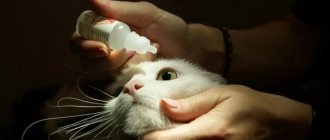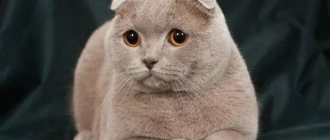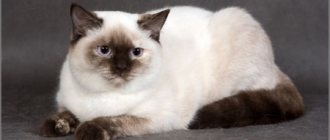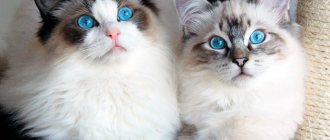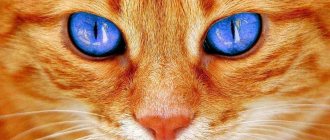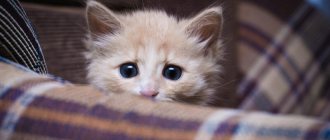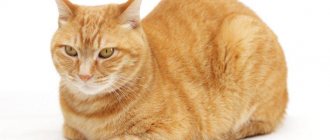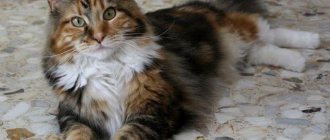Before choosing a kitten, you need to pay attention to its color. Research by scientists from different countries has proven that color influences the character and habits of the animal. Based on the color of pets' fur, they can be divided into typical groups. Having studied the characteristics of each species, it is possible to choose exactly the cat that suits the temperament. But in order to make the right choice, you must take into account your character.
Black magic cats
Such a pet will not allow its owner to suffer from headaches.
There is a myth that these cats are related to mysticism. This is due both to the appearance of the animal and to the fact that they subtly sense the state and mood of the owner. Black cats, on the one hand, are self-sufficient and independent, and on the other hand, they know how to cheer up, feel sorry for and even cure a headache. They are not aggressive, easy to navigate, and react to changing weather. Representatives of the black color are graceful, love to take beautiful poses and will become a decoration of the house.
American Studies
American scientists from the University of California recently tried to confirm this by asking more than a thousand owners of cats of different colors to answer the question under what circumstances and how many times a day their pets show aggression.
According to the website vesti.ru, it turned out that the most aggressive are tricolor cats, which can bite and scratch when trying to pick them up and are generally very harsh in everyday communication with the owner.
Black-and-white and gray-white animals are also not very agreeable, but unlike tricolor animals, they behave worst of all when visiting a veterinarian. But as a result of the study, cats of uniform black, white or gray color, as well as striped ones, were recognized as the kindest.
With sound reasoning, it becomes clear that the study, to put it mildly, is very subjective. The character of a cat is not directly related to color, because the character of an animal is influenced by many different factors, both genetic and social, and this question, as far as follows from the publication, has not been clarified at all.
Spots and stripes on hunting cats
Such cats are familiar and familiar; they can be from white to “mustachioed-striped.” Stripes are balanced, not prone to hysterics and whims, and not vindictive. They quickly get used to new conditions and surroundings. We are used to relying only on ourselves. Self-reliance and independence are the main traits of their character. By nature, they are hunters (this is influenced by natural agility and activity), but they are attached to the house and to the owner, they love to warm themselves in their arms or take a nap in a warm place. If you pick up and bring a spotted or tabby cat into your home, the house will become happy and the money will not be lost.
Two-color cats are doubly treasures
Among these pets, most have a balanced character.
Bicolor is the name of the two-colored color of pets. The character of two-color cats determines the dominant color. The colors are very diverse, for example, black and white, white and red, chocolate gray and many others. These animals require increased care: thorough bathing and combing, and once every 10 days. These cats have:
- softness;
- kindness;
- poise;
- friendliness;
- obedience.
Blue cats
These animals have their own opinions, easily make decisions and follow the rules of behavior established in the house. Such a pet can determine by the owner’s mood what is expected of him. The cat's character is almost perfect. Curious, happy to keep company on a walk. Blue cats will find a common language with children. They are smart and observant, they understand human speech. They get along with other animals in the house and are open to communication with them.
These pets are suitable for those who are looking for a smart, affectionate, tolerant and devoted friend.
Color - character: conditional data
But be that as it may, many people believe in the special features that are inherent in this or that color of cats. Especially for them, we present this data, which is relevant for outbred cats and mixed breeds.
We warn you that we are not responsible for the accuracy of this information. Why - read above! And besides, we are sure that one of the main factors shaping the character of an animal is the relationship that a person has managed to build with it.
Early socialization, a deep understanding of a cat's instincts and behavior, kindness and affection can actually work wonders.
Black Cats
Loyal, suspicious of strangers, good-natured, persistent, friendly and sociable.
White
Calm, peace-loving, friendly and timid cats.
Redheads
These cats are well-mannered, cunning, unpredictable, unfriendly and hot-tempered.
Blue
These are affectionate, quiet, gentle, calm and peaceful cats.
Blue cream (diluted tortoiseshell)
Animals of this color are lively, active and mischievous.
Tortoiseshells
This color is found only in cats. They are, as a rule, good mothers, quick-witted, naughty, hot-tempered, and temperamental.
Calico (tortoiseshell and white)
These are calm, good-natured, mischievous and active animals.
Black and white
Bicolors are calm, balanced, friendly, and love to travel.
Tabby
Tabby cats are phlegmatic, good-natured, lethargic, homebodies, good for indoor keeping.
Spotted
Pets with spots are very friendly.
Black smoky
Cats of this color are relaxed and good-natured.
Chinchilla
Very gentle and good-natured.
Cameo
As a rule, cats of this color are apathetic.
Color point (Siamese color)
Always gentle, energetic, but restrained.
Tabby - brindle cats
Such pets splash out excess energy during games.
An ancient and common color of cats. These animals are similar to their relatives - wild cats. There are: marbled, striped, spotted. Tabbies always want to be the center of attention, always in the company of people. They have endless energy and love to play. These large representatives do not require special care. They are attached to the owner, but at the same time get along with other pets in the house. Such a pet needs a spacious home. Before you get one, please note that brindle cats have health problems.
How does a cat’s behavior depend on its breed, color and eye color?
Author: Chikurova Evgenia
Review of the article Wilhelmy J., Serpell J., Brownb D., Siracusa C. “Behavioral associations with breed, coat type, and eye color in single-breed cats” // Journal of Veterinary Behavior 13 (2016) 80-87
Bengal cat
Since ancient times, different peoples have had many superstitions about how the character, health and even fate of an animal depend on its color and eye color.
Some folk signs are confirmed by science, such as the increased frequency (up to 80%) of deafness in white cats with blue eyes, and it is even known why this happens (Bosher, Hallpike, 1965).
Other signs have not yet been verified.
Still others are not confirmed during testing and are probably related not so much to the color of the animal, but to the prejudiced attitude of people towards this color. And in general, people’s preconceptions have distorted and continue to distort many facts.
This is why I am suspicious of numerous studies whose results are based ONLY on surveys and are not supported by anything else, such as observations or experiments. When conducting a survey, it is especially useful to also analyze test tasks, when, in addition to the survey, people are asked to evaluate something that has already been evaluated by a dozen experts and, depending on the answers, the result is adjusted. For example, they ask whether women agree with a number of statements, among which is: “Hitting means loving,” and then conduct a survey on whether these women believe that they are subjected to domestic violence).
The study of American scientists that I will analyze today is based only on the analysis of questionnaires. And I would immediately classify this study as questionable if some of its conclusions did not turn out to be the same as other independent studies. Some connections between a cat's character, its color and its breed do seem to exist, and this is important for breeders and those who are planning to purchase a kitten of a certain breed.
Perhaps the large number of questions in the questionnaire (as many as 149) reduced the influence of respondent bias and made the research results more objective.
Review of previous studies.
A number of studies (Serpell & Hsu, 2005; Duffy et al., 2008; McGreevy et al., 2013; Ghirlanda et al., 2013), which used a standardized questionnaire, have already shown differences in dog breeds in aggressiveness and learning ability. In the article we're looking at today, the authors used a similarly designed Cat Research Questionnaire (C-BARQ).
Burmese cat
Please note here that one of the authors, Serpell himself (who is also the author of the questionnaire), refers only to works in which he was a co-author (don’t let the first names confuse you - he is one of the co-authors, I checked). Well, that is, he uses himself to prove it. Perhaps he simply has nowhere to escape from this, since there are not many detailed questionnaires and it is easier to use the one he compiled himself.
I will list what is already known from the literature and is discussed by the authors of the article that interests us:
Svartberg (2006) showed that dogs bred for exhibition were significantly less playful and aggressive than their hunting counterparts.
Devonrex
Kim et al. (2010) showed that in the Korean Chindo dog breed (a group of Spitz breeds and primitive breeds), fawn-colored specimens are superior to their white counterparts in courage and have a more subtle sense of smell, while white Chindos are calmer and more often demonstrate submissive behavior.
Amat et al. (2009) using the Campbell test (one of the standard tests for checking puppies for activity and tendency to dominance) showed that the tendency to aggression decreases in English cocker spaniels in the fawn-black-spotted series.
Batt et al. (2008) showed that black and fawn Labradors have different abilities to solve search problems (I looked at that article, I have questions for the authors about statistics).
Keeler (1942) and Hayssen (1997) showed that wild-colored rats and mice exhibit more “wild” behavior, and wild-colored rats were shown to have a more refined sense of smell.
Novosibirsk foxes are also mentioned, and the connection between selection for friendliness to humans and the appearance of spotting (Trut et al., 2004).
Mendl & Harcourt (2000) examined feedback from veterinarians, cat show judges and owners. The judges note that Siamese are more demanding of attention from strangers, while Russian Blues are more shy and cautious. Veterinarians have noted that Siamese meow actively, while Persians are less active and less prone to destructive actions than Oriental shorthaired breeds. The owners noted that Siamese are more sociable and “talkative” than Persians.
Hart et al., (2013) surveyed veterinarians about 15 different cat breeds. According to these data, veterinarians consider Bengals to be the most active, often showing aggression towards members of the owner’s family, and more often marking, while Persians are the least active and least likely of all other breeds to gut the trash.
Abyssinian cat
Marchei et al. (2009) conducted an “open field” test, where they showed that Siamese, Abyssinians and Orientals reduced mobility earlier (stopped being active more quickly) than Norwegian forest cats. (Although, according to my observations, all these breeds are curious “electric brooms”)
Based on one study on the deafness of white cats with blue eyes (Bergsma & Brown, 1971), the authors of the article argue that “selection for a particular color phenotype leads to significant changes in behavior.” What can be argued with, since, firstly, in deaf cats the behavior, of course, changes, but this is a secondary change, the primary one is deafness, and secondly, in addition to this example of confirmation of the folk superstition about the connection between color and behavior, there are still a lot of unconfirmed and unverified similar signs, as I already reported at the beginning.
Mendl & Harcourt (2000) studied the behavior of 84 British shorthair kittens when interacting with an unfamiliar person. The behavior of the kittens differed depending on the color: red, cream and tortoiseshells took longer to calm down and make attempts to escape compared to kittens of other colors.
Tonkinese cat
Pontier et al., (1995) showed that in rural France, out of seven possible colors, ginger cats are more common. From which the scientist concluded that ginger cats probably have different reproductive abilities than others.
The purpose of the study of the article we are interested in, the authors called the search for relationships between breed and behavior, as well as, regardless of breed, relationships between behavior and coat color, spot pattern and eye color.
Methods.
Only those recognized by all three major international felinological organizations were recognized as cat breeds. Partially completed questionnaires and questionnaires with unrecognized breeds were excluded from the study, and breeds whose representatives were less than 15 in the survey were also excluded (they were about 2/3 of all results); in total, 394 questionnaires were used in the calculation - significant material.
For all the studied phenotypes (color, pattern and eye color), the authors found research by geneticists to understand how these colors are encoded and the combination of which alleles they depend on.
Cat owners were asked to fill out a questionnaire (online) in various ways, including through Facebook.
Each participant could fill out the questionnaire for three of their cats. Those whose household had more than three cats had to choose three of them whose names came first in alphabetical order (this reduces the likelihood of choosing favorites).
There were 12 breeds in total: Abyssinians, Bengals, Burmese cats (Burma), Burmese longhairs (France), Devon Rex, Maine Coons, Norwegian Forest, Orientals, Persians, Shimaskies, Ragdolls, and Tonkinese.
Maine Coon
A little about the questionnaire that the owners filled out: there were 149 questions, thanks to the answers to which you can form a fairly complete picture of the cat’s behavior (if you exclude the influence of the owner’s perception on the survey). A number of themes were identified: activity/playfulness, sociability with people, acoustic communication with people (“talkativeness”), demand for attention, communication with cats, aggression towards the owner, strangers, dogs, familiar cats, fear of novelty and of unfamiliar dogs/cats , tolerance to holding and touching. As well as separation anxiety, predatory behavior, interest in prey, sleep behavior, excessive/compulsive (obsessive) auto-grooming, other compulsive behavior (stereotypes), inappropriate excretory behavior (marking), etc. Several questions were devoted to each topic.
Results.
There were approximately equal numbers of cats and cats in the study (48% and 52%). 79% were spayed/neutered, 4% had their claws removed (this affects behavior! But 4% has little effect on the statistics as a whole. And I was pleased to read that so few animals were crippled). 85% of the animals in the study lived in homes with many cats (more than 3) (which suggests that the behavior of the cats studied was also influenced by other cats).
The age of the cats was not taken into account.
Statistically significant differences in the propensity for playful behavior were shown by Persians and Burmese - on average, they are less playful than others (but this does not mean that you cannot play with them!), and Devon Rex and Tonkinese turned out to be the most playful (most likely their owners will have to buy a lot of toys and devote more time to entertaining your pets). Burmese and Persians also exhibit hunting behavior significantly less than others (if you don’t need a rat-catcher cat, this is more good than bad), and the most active hunters turned out to be Bengals (while the laziest Bengals in terms of mobility are approximately on the same level as the most active Persians).
Although most of the behavioral traits were related to breed, some color effects were observed.
Persian chinchilla
Regardless of the breed, agouti cats are significantly more likely to demonstrate aggression towards other cats (So, if you have a cat of this color, be prepared for the fact that she will want to be the only one in your home and heart). Red cats are significantly more likely to show fear aggression (toward strangers) and beg. Lilacs are more likely to be anxious when separated (you will need to come up with entertainment for them during your absence or take care of leaving them with someone). Silver and chinchilla cats more often show fear aggression towards familiar cats, spotted cats (with white spots) are significantly less likely to show aggression towards strangers.
Valuable.
A rather convenient table has been compiled where you can find the breed of cats and discover which behavior tends to show more and which behavior shows less. A similar table has been compiled for colors, but the influence of color is more often characteristic of a specific breed than for all cats of this color. Part of this table is shown below.
Many of the authors’ conclusions are consistent with data obtained earlier, and, importantly, including other methods. Thus, there is a generally reduced playfulness among Persians; Bengalis are more likely to “mark.”
There were also differences. For example, the authors did not find an increased tendency in Siamese to meow and be sociable, although other studies report this (I don’t know which version to believe now, because all the Siamese I know (about four of them) loved to “talk”). This may be due to the specifics of the work sample - only 23 countries and half of the results were obtained from US residents.
The authors also acknowledge that the results of the questionnaire could be influenced by various factors that they cannot exclude.
Norwegian forest
Conclusion.
The results of an analysis of questionnaires of cat owners from 23 countries show that some behavioral characteristics of cats are associated with breed. Color is even less related to behavioral characteristics. But those few connections between character, color and breed that have been confirmed in several independent studies do exist. Now it is a task for geneticists and physiologists to understand the reasons for these connections.
Cats were domesticated relatively recently, later than most other domestic animals. Understanding the inheritance of their behavior could help breeders produce kittens with predictable personalities, which in turn will help people choose a pet that suits their lifestyle. As a result, both the cats themselves and their owners will live in happy harmony with each other.
Tortoiseshell beauty
These cats got their name due to their color; there is no such separate breed. This color is a mixture of red or red and black, shades of sand, cream and ash. The personality of tortoiseshell cats consists of a number of unique features. This is a strong will, eccentricity, irritability, unpredictability and independence. They are smart and jealous of their owner. Turtles are sociable, playful and more active than other cats. Such a multi-colored miracle will bring good luck and protection to the house, and will become a faithful and devoted friend.
Chinchilla cat
This is a cute creature with an aristocratic character. She is a flexible, intelligent and affectionate animal. According to chinchilla color, they are divided into three types: silver, shaded silver and golden. The chinchilla is compliant and friendly, but at the same time requires increased care. If you don't pay special attention to her, she becomes depressed. Chinchilla kittens are playful, while adults are reasonable and reserved. But they do not get along with other pets. Chinchillas tend to be overweight, so they need proper nutrition and an active lifestyle. This must be taken into account if you want to take such a sole farmer into your home.
Scientific approach
So, is there any homespun truth in such statements and folk myths about cats of different colors? In order to detect it, it is necessary to seek the help of scientists, because only they can reliably prove the “color-character” connection, that is, the parallels between the genetically determined behavioral characteristics of cats and the color of their coat, which is also genetically determined. Unfortunately, this question remains open for now...
Belyaev's experiment with foxes
Indirectly, the possible existence of such a connection is indicated by an experiment that is not at all related to cats. It was carried out since 1959 by the Russian biologist D.K. Belyaev at the scientific station in Novosibirsk. The goal of the experiment, which, by the way, is still ongoing, is to breed a domesticated fox.
Only relatively loyal animals with low aggressiveness were selected for crossing. As a result, already in the fifth generation, not only the character of the foxes changed, but also the color of their fur! White spots, found in wild counterparts only on the tip of the tail and chest, decorated the domestic foxes all over the body and even scattered like stars on the face.
The results of the experiment are thought-provoking, but foxes have not yet been able to obtain such a variety of colors as in cats, which means there is little room for imagination. In the case of our pets, only the connection of red and tortoiseshell color with the gender of the animal, but not with character, has been proven so far.
Aggression and natural selection
As for the latter, everything seems to depend solely on the data of the parents, no matter what color they are. If a breeder of purebred animals does not think about selecting sires based on their character, then it is impossible to give any guarantees of the docility of the resulting offspring.
And in this sense, a kitten from the street, that is, born through natural breeding, can turn out to be much nicer and friendlier. The fact is that increased aggression in nature, and especially in the urban environment, is a factor that impedes the well-being of the animal.
Aggressive cats often die from injuries received in fights and are expelled from established street prides, which means they leave fewer offspring.
An aggressive cat is constantly in a nervous, excited state, which is why she makes mistakes, gets into life-threatening situations, and even loses kittens as a result of miscarriage, or they are born dead.
